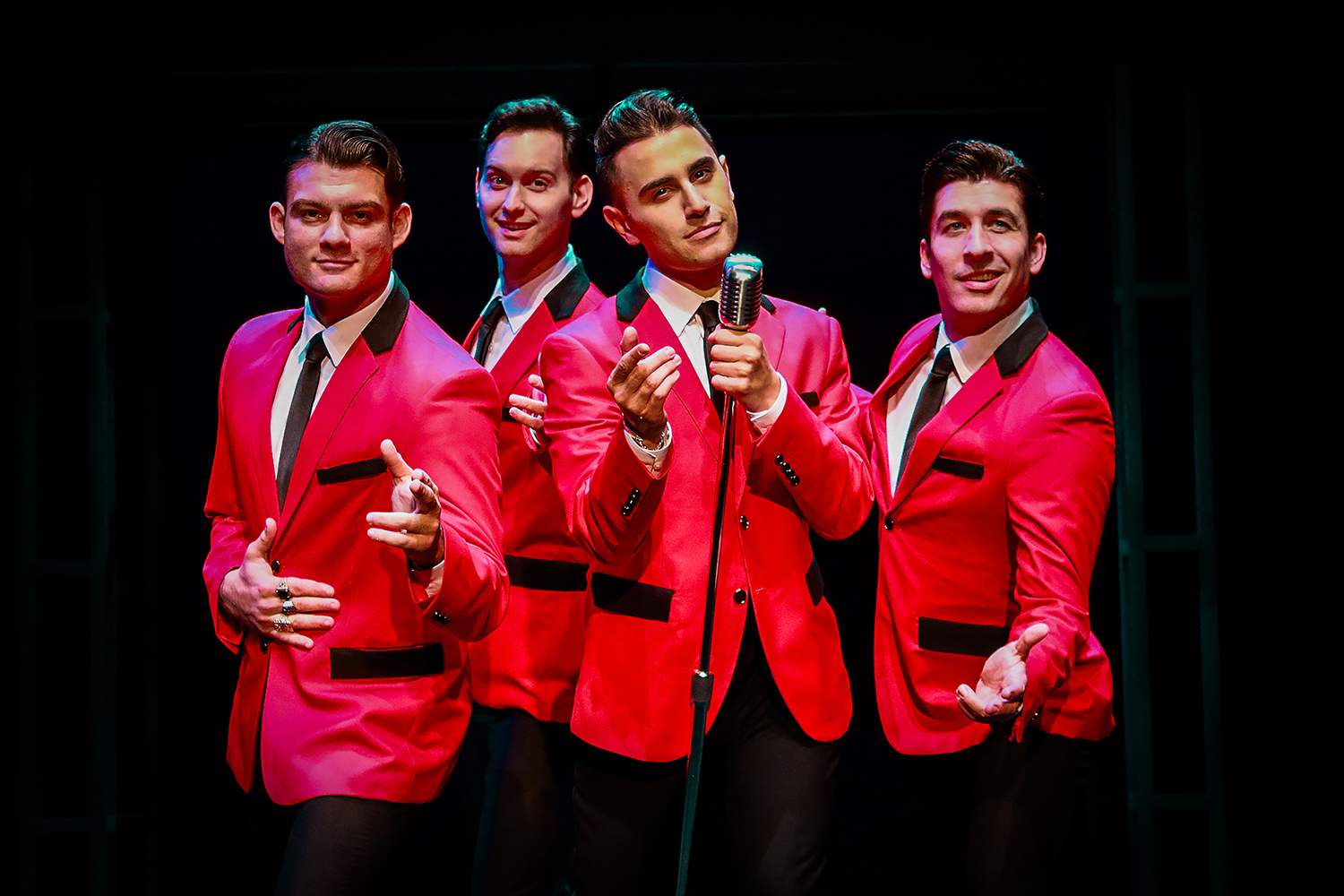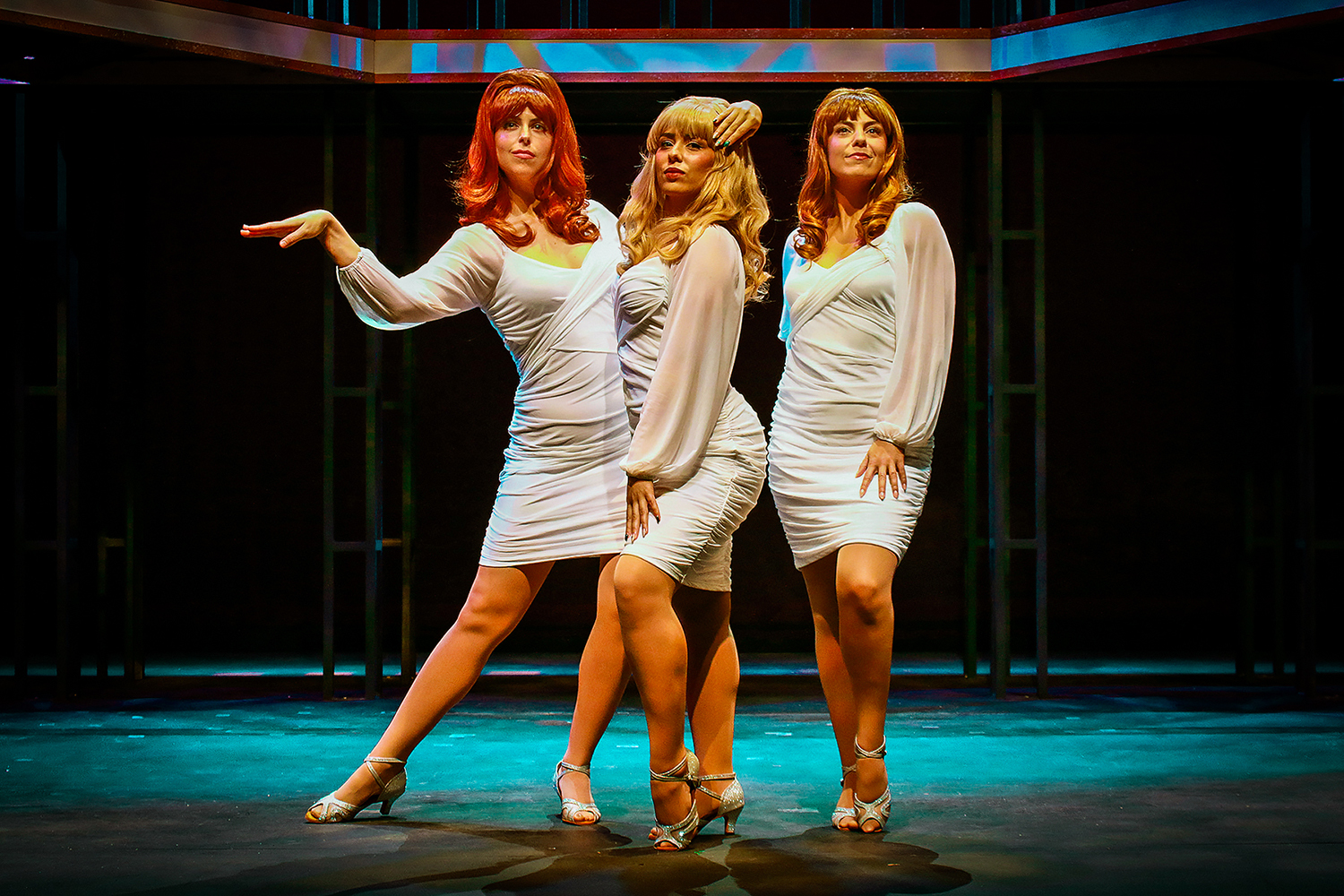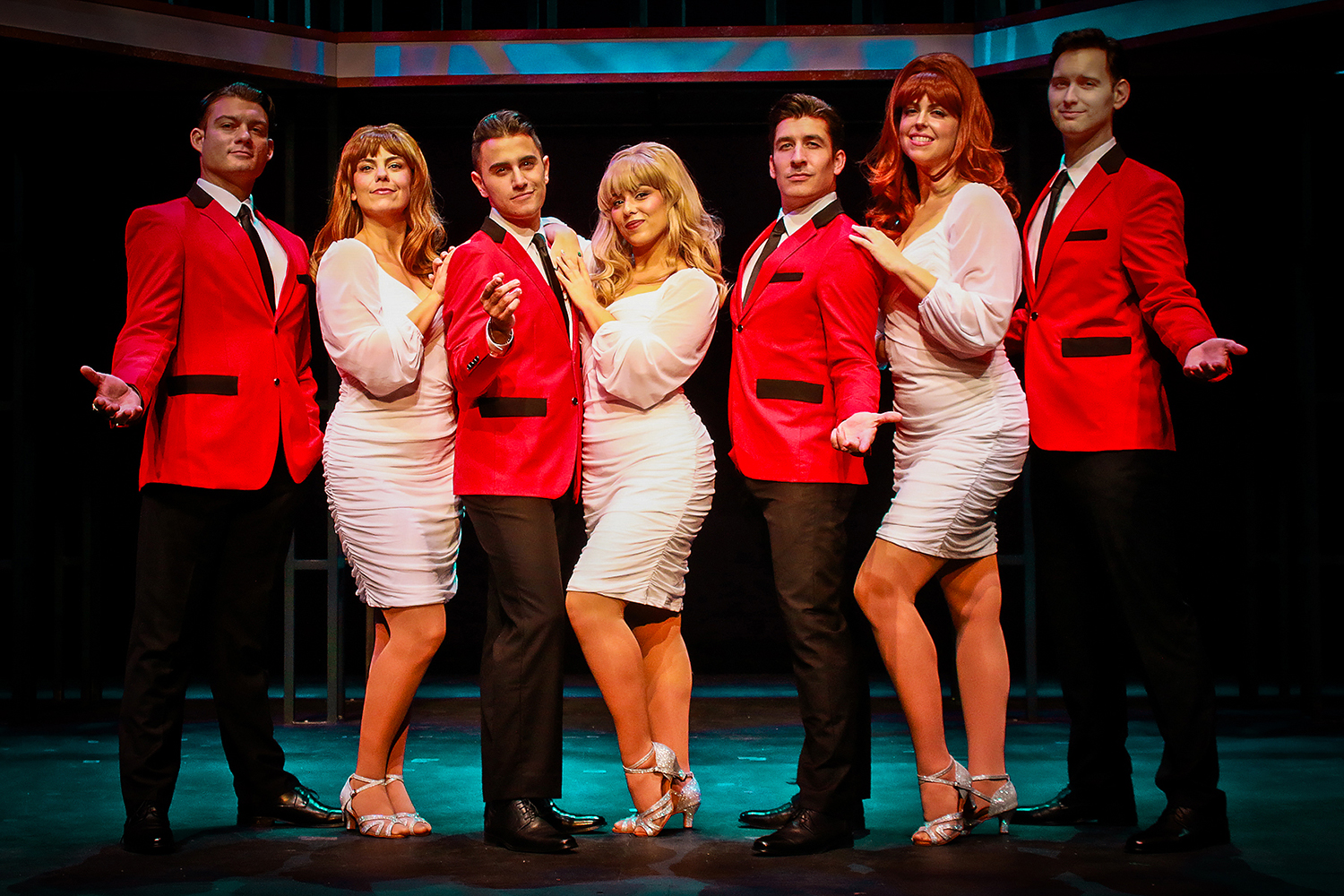
Domenic Servidio (Nick Massi), Quinn Corcoran (Bob Gaudio), Joshua Charles Skurnik (Frankie Valli) and Nathan Cockroft (Tommy DeVito) star in "Jersey Boys" at Actors' Playhouse at the Miracle Theatre (Photo by Alberto Romeu)
Oh, what a night, indeed.
We can’t take our eyes off the Miracle Theatre’s stage, because, on it, those irresistible boys from Jersey come alive so vividly that you want to cheer. Doubtless, they seem as real as the redness marking your hands because you've clapped so hard.
After trying to secure the performance rights to “Jersey Boys” for 20 years, Actors' Playhouse Artistic Director David Arisco has finally succeeded. And, so, it is time to rejoice, rewind, and unwind as beloved and familiar songs from yesteryear soar through the air and leap into your heart. Truly, a glorious sound emanates from the stage, thanks to not only the performers, but sound designer Reidar Sorensen.
Of course, this international musical phenomenon’s full title is “Jersey Boys: The Story of Frankie Valli & The Four Seasons.” And while the show runs roughly two-and-a-half hours, including a 15-minute intermission, it never drags. Besides, you never worry about the running time. In fact, you may not want the show to end. Fortunately, this production runs at the Miracle Theatre in Coral Gables through Sunday, Feb. 23. Therefore, you still have some time to hop on and let Actors Playhouse whisk you back to the 1960s.
Under Arisco’s smart direction, Actors' Playhouse’s production features four triple threat performers as the titular “Boys.” They are hardly new to the show; these performers have done it in “in many different ways with different directors and different people,” Arisco has said. Chances are, that is why it all looks and sounds so effortless.

Carolina Ordonez, Lauren Horgan and Elaine Cotter in "Jersey Boys" at Actors' Playhouse at the Miracle Theatre (Photo by Alberto Romeu)
This production stars Joshua Charles Skurnik as Valli, Domenic Servidio as Nick Massi, Quinn Corcoran as Bob Gaudio, and Nathan Cockroft as Tommy Devito. In addition, a strong, large supporting cast featuring local and non-local performers portray a variety of characters whose lives intersect with the titular characters. They are everybody from family members to members of the mob.
If you have reached a certain age, the Four Seasons’ music will likely satisfy your nostalgia for a simpler time of innocence and hope. These songs are hits such as “Sherry,” “Big Girls Don’t Cry,” “Can’t Take My Eyes Off You,” “Dawn,” “My Eyes Adored You” and “December, 1963 (Oh, What A Night)."
But “Jersey Boys” is not a concert. Rather, it is a touching, funny, smartly-structured, action-packed jukebox musical. It neatly captures the Four Seasons’ bright moments and somber ones.
The musical ran on Broadway from 2005 to 2017 and spawned multiple national tours. The show has also run overseas, captured four 2006 Tony Awards, including Best Musical, and the 2009 Laurence Olivier Award in Great Britian for Best New Musical. By the way, a jukebox musical is one that features mostly well known, pre-existing popular songs.
After trying out several titles, the musical group came up with Four Seasons after the name of a bowling alley. Librettists Marshall Brickman and Rick Elice structured the show in such a way that different sections of the musical correspond to the seasons of the year.
At the beginning of the musical, “Spring” stands for the group’s beginning, just as that season symbolizes new beginnings. The second part, “Summer,” symbolically suggests the brightness and success these “Jersey Boys” enjoyed at the time. It’s fitting that just after the “Summer” sequence begins, the performers sing “(Who Wears) Short Shorts.” The show’s creators have generally arranged the songs so that they make sense within the musical’s context.
Following “Summer,” things turn bleak for the “boys,” just as the days in New Jersey and other parts of the north are shorter, darker, and drearier than the warmer months.

Domenic Servidio, Elaine Cotter, Joshua Charles Skurnik, Lauren Horgan, Nathan Cockroft, Carolina Ordonez and Quinn Corcoran in "Jersey Boys" at Actors' Playhouse at the Miracle Theatre (Photo by Alberto Romeu)
A different group member narrates each “season” or section, telling the foursome’s story from his perspective. Everybody, pardon the cliché, sees the same thing differently.
The production also includes a nine-piece live band stationed upstage and providing rich accompaniment under conductor Clay Ostwald.
The performers energetically and seemingly effortlessly act, sing, and dance on scenic designer Brandon M. Newton’s symbolic two-level set. Scenic pieces standing for different locales seamlessly enter and exit the stage in between scenes.
The set’s two levels could symbolize the highs and lows of the titular characters’ lives and careers, the group’s rise and fall. Just as we experience highs and lows, the performers alternate between playing on the set’s first and second levels, which also helps the production achieve variety. Winding staircases connect both levels. The staircases’ windiness could suggest that oftentimes, the path upwards toward success is not straight and smooth, but rather turbulent, winding, and dizzying.
Eric Nelson’s varied lighting sets appropriate moods and the backdrop often changes colors. Also, the performers often change costumes (Ellis Tillman designed the period formal outfits), just as the characters’ life circumstances often change.
Speaking of changing, Valli, the Four Seasons’ lead singer and falsetto vocalist, undergoes a change. Specifically, when the show begins, he is basically an innocent, eager youngster. As the show progresses, he seems to grow into a more confident and seasoned (pun intended) musical artist. The change happens gradually, practically unnoticeably through Skurnik’s skillful portrayal.
As Valli, Skurnik nails the falsetto, that seemingly impossibly high voice for a male singer to execute, let alone with clarity and control. But Skurnik’s Valli achieves both, particularly during the highest notes of “Sherry.” Skurnik, with wide, dark eyes, also conveys Valli’s determination and grit, and he is believably heartbroken following a tragedy.
A pure, fresh-faced Corcoran radiates positivity, eagerness, and a “can-do” attitude as Gaudio, a singer-songwriter who composed many of the Four Seasons’ songs.
A tall, imposing, dark-haired, and understated Servidio slips into the skin of Massi, the group’s guitarist who helped Valli with his singing. Servidio’s Massi is like a big brother to Skurnik’s Valli.

Domenic Servidio, Joshua Charles Skurnik, Nathan Cockroft and Quinn Corcoran star in "Jersey Boys" at Actors' Playhouse at the Miracle Theatre (Photo by Alberto Romeu)
As DeVito, the band’s lead guitarist, Cockroft possesses an appealing, charismatic, cool quality with a hint of a bad-boy demeanor. He is a smooth talker with slick-backed dark hair.
As a group, the foursome harmonizes well and sounds and looks like they have been performing together for a long time. Wisely, Arisco moves them around the stage, keeping the proceedings lively.
While Arisco directed the production, Sarah Crane served as the associate director and choreographer. For the most part, the choreography is as vibrant as the characters’ personalities, and the cast deftly dances.
The titular characters are hardly perfect. “None of us were saints,” one of them reminds us. But they are gritty, determined, mentally tough, and are searching for what our immigrant grandparents sought so fervently – success and happiness that come with the American Dream.
The sun is not always shining on folks during their quest for that elusive happiness and prosperity. Indeed, dark moments accompany the bright and cheery ones. Some moments are so bleak that recovery seems impossible. But the titular characters never seem to give up, and that is partly what endears us to them.
In addition to the performers playing the title characters, the cast includes Michael Scott Ross, Tony Lawrence Clements, Seth Trucks, Corey Vega, Elaine Cotter, Lauren Horgan, Carolina Ordonez, Don Seward, and Alexander Blanco.
You knew it was just a matter of time before Actors’ Playhouse, an award-winning musical theater powerhouse, staged “Jersey Boys.” Certainly, this production would make the original “Boys” proud.
IF YOU GO
WHAT: “Jersey Boys.”
WHERE: The Miracle Theatre, 280 Miracle Mile in Coral Gables.
WHEN: Performances run at 8 p.m. Wednesday through Saturday, with matinees at 3 p.m. Sunday.
TICKETS: Prices range from $50 to $100. Tickets at (305) 444-9293, www.actorsplayhouse.org, or at the box office. The theater offers 10 percent off all weekday performances for seniors and $15 student rush tickets to any performance 15 minutes before curtain with identification. Actors’ Playhouse offers group discounted rates.
 MAIN MENU
MAIN MENU

